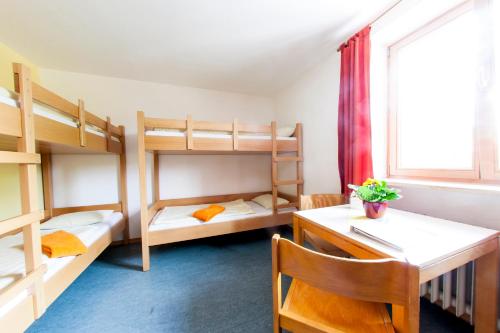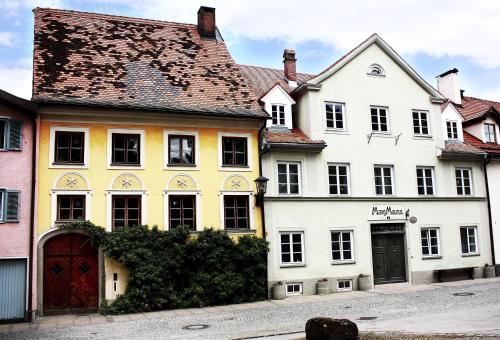There’s nothing around but the rolling green fields of the Bavarian countryside. Oh, and the white church in the meadow.
Its neighbours are cows, who lazily chew their cud, and horses that look at me expectantly as I walk past
The Wieskirche Church is in an odd location, with hardly a parishioner for miles around it. But it’s not a church designed for local worshippers. It’s for the pilgrims.
What is the Wieskirche?
The Wieskirche was built in the 18th century after tears were apparently seen coming from a wooden statue of the flagellation of Christ, known as the Scourged Saviour, in 1738.
A true miracle, it was declared, even though there seem to be very few details about the supposed event.
The source of such a miracle needed an appropriate building to house it – and the small chapel that was originally erected was not enough. Something bigger and grander was needed not just to commemorate the event, but to house all the pilgrims that would come.
And so the Wieskirche was built in a meadow in rural Bavaria, about 100 kilometres from Munich, and opulently decorated (although it appears more austere from the outside).
The Wieskirche, also known as the Pilgrimage Church of Wies, was added to the World Heritage List in 1983. This was partly because of the magnificent rococo design inside the church, and also because of its significance as a destination for pilgrims from across the region.
The history of the Wieskirche
The wooden chapel originally built over the statue of the Scourged Saviour needed to be enlarged within years.
Because of the pilgrims, it needed to not just be large, but impressive. However, it was important it wasn’t done in a way that would seem ostentatious in the middle of the quiet 18th century countryside.
Work on the new church began in 1745 under the architect Dominikus Zimmermann. The choir was consecrated in 1749 and the rest of the building was finished by 1754.
The structure is not particularly large, especially by comparison to the enormous German churches like Cologne Cathedral or Speyer Cathedral. Much of the time spent building it was focused on the artistic elements inside.
The beautiful stucco decorations are also the work of Dominikus Zimmermann, although he was helped by his brother, Johann Baptist, who was a professional painter.
During the 18th century, the Wieskirche became one of the most important pilgrimage sites in Europe. Many of those who came and prayed to the wooden statue of Jesus claimed they were miraculously cured of diseases… and so even more came.
The little white church on the top of a grassy hill offered salvation to the flocks that walked here past the ones that grazed here.
The Wieskirche had extensive renovations done to it between 1985 and 1991 but, rather than change the design or the features, this work expertly returned the exterior and interior to its original glory, which we can appreciate today.
And it’s the rococo interior in particular that makes the Wies Pilgrimage Church so special.
Things to see at the Pilgrimage Church of Wies
From the outside, the Wieskirche Pilgrimage Church feels tranquil, with soft rounded white edges. This is intentional, to fit into its rural setting.
Inside is different, though. There is an explosion of colour and intricate detail.
The interior is decorated in what is considered to be one of the best examples of rococo architecture in this part of Germany and, when you visit the Wieskirche, make sure you take your time to admire each little element of what you find here.
The lively colours of the paintings bring out the sculpted detail.
The ceilings are covered with painted scenes.
Statues hang to columns and seem to cheer their surroundings.
Golden trims and complex plasterwork fill the main section of the building.
Around the altar, the colours and artwork become even more intense.
Throughout all of this artistry are an abundance of motifs and a living decor of rich hues and playful light, where you lose sense of how small the church actually is, because it feels like you’re up amongst the clouds, in a golden temple with angels flying about you.
The interior design and associated art are also intended to reflect the spirituality of the pilgrimage that so many people did to arrive here, and to show themes of suffering and penance.
The main ceiling fresco of the resurrected Christ and the door to eternal life shows the central theology that redemption is born from sacrifice.
But it’s just one of the artworks to take particular note of. If you can, you might like to visit with a guide who can tell you more about the specific elements.
Visiting the Wieskirche
The closest main tourist town to the site is Füssen and most independent visitors will set out from there to visit the church.
There are a lot of other interesting places to see along the way, including the famous Neuschwanstein Castle. It’s easy to make a day trip around this region and include the Wieskirche as part of that.
If you’re coming from Munich, I would recommend this excellent tour that takes you to both the Wieskirche and to Neuschwanstein Castle.
Although there’s very little around the church itself, there is an excellent restaurant right next to it serving traditional Bavarian food inside or outside.
The church itself is small and only takes a few minutes to walk through. However, you should give yourself at least 30 minutes to look properly at all the frescoes and artwork decorating the interior. There are a lot of small details that take time to become obvious.
Where is the Wieskirche?
The Pilgrimage Church of Wies is located at:
Wies 12, 86989, Steingaden, Germany.
You can see it on a map here.
How do you get to the Wieskirche?
To get to the Pilgrimage Church of Wies, catch the train to Füssen and then take bus number 73 to the site, which takes about 40 minutes.
When is the Wieskirche open?
The church is open at the following times:
January and February: 08:00 – 17:00
March and April: 08:00 – 19:00
May to August: 08:00 – 20:00
September and October: 08:00 – 19:00
November to December: 08:00 – 17:00
How much does it cost to visit the Wieskirche?
Entry to the church is free although there is a voluntary donation box.
Are there tours to the Pilgrimage Church of Wies?
Yes, there are a couple of good tours that will show you the church and some of the other highlights around this part of Bavaria.
There is this day tour from Füssen that also includes the famous Neuschwanstein Castle.
Or, if you’re coming from Munich, there’s this excellent tour that also includes Neuschwanstein Castle.
More information
You can find out more information at the church’s official website.
Much like the thousands of pilgrims who came before, the journey to the Wieskirche and the surrounding region is part of the pleasure.
The closest town to the Wieskirche is Füssen and, if you would like a base in the area, there are some lovely hotels there. It’s much easier than staying in Munich, and I think you’ll also find it quite relaxing.
THE BEST ACCOMMODATION IN FÜSSEN
For a relatively small town, there is a great selection of places to stay in Füssen.
BACKPACKER

For a good budget option, I would suggest the DJH Youth Hostel right near the train station.
BUDGET

For a friendly but affordable hotel, try the popular Maurushaus.
BOUTIQUE
If you like the idea of somewhere a bit more fairytale, have a look at Hotel Fantasia.
LUXURY
Or you could treat yourself to the wellness and spa facilities at Hotel Sommer.
Time Travel Turtle was supported by DB Bahn, the German National Tourist Board and Youth Hostels in Germany but the opinions, over-written descriptions and bad jokes are his own.
Stunning! Beautiful photos, Michael.
Definitely looks like the sort of place you would need to take time to soak it all in, and look at the detail.
I love churches that feel so bright and airy. Looks like this one is in a gorgeous location, too.
Seems like an interesting place to visit … was just at the Metropolitan Cathedral in Mexico City, so I’m in the mood for seeing churches now!
It looks gorgeous! Very interesting history going along with it as well. Thanks for sharing!
Beautiful spot! It looks like a great place to have a picnic after and enjoy the views of the countryside.
This pilgrimage church is one of the most beautiful and serene in all Europe. It is well worth a visit!
We went through Füsen and did not know about the Wisekirke our next visit This architectural wonder will be top on our list
Is wieskirke open on
25 December 2023?